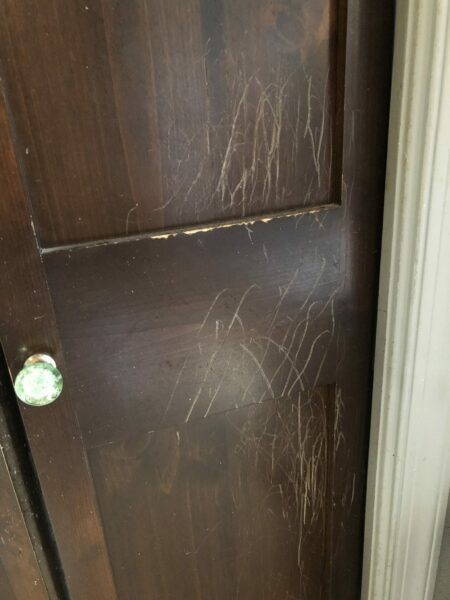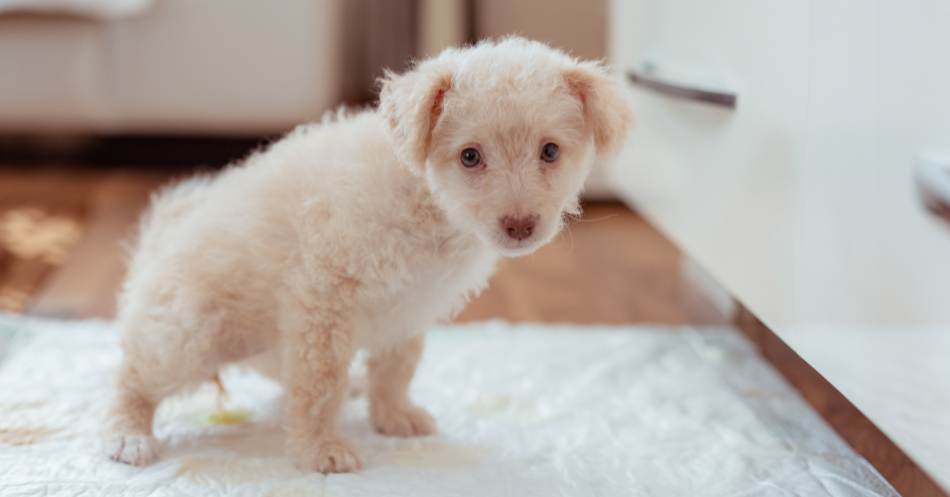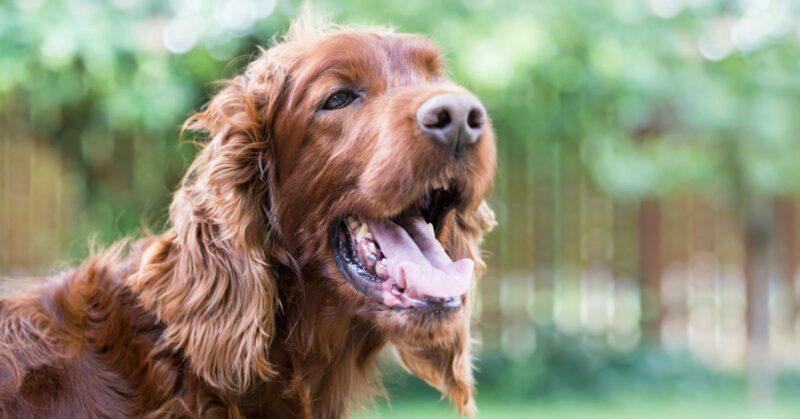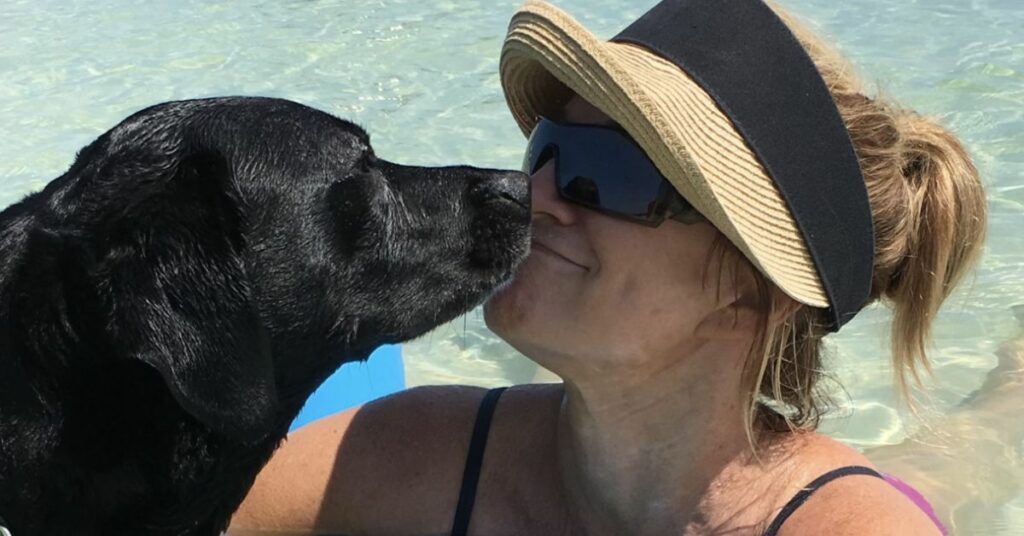
How to Calm a Dog Scared of Fireworks
Loud noises can be terrifying for dogs with noise aversion. This kind of fear goes beyond a mild dislike of noise. In fact, noise aversion is a diagnosable medical condition that, without proper treatment, can make your dog truly miserable.
Fireworks, in particular, can cause some dogs to show serious signs of anxiety. If this is the case with your dog, rest assured he doesn’t have to suffer.
In this post, I’ll share ways to help your dog manage his noise-related anxiety and reach a calmer state of mind, even in the middle of a raucous holiday like the 4th of July.
While the information shared in this post is largely focused on fireworks, it can also be useful for dogs battling reactions to everyday noises like doorbells, alarms and ringtones, lawn mowers, indoor and outdoor construction, and traffic.
Pin Me!

Managing Our Dog’s Noise Aversion During the 4th of July

Fireworks are big, bold, flashy, and loud. It’s no wonder many dogs are afraid of them. In the past, I used to look forward to the fireworks and festivities around the 4th of July, but when Chilly came into our lives, that changed. I started dreading the holiday because of the negative effect it had on him.
The sound of fireworks would send him into a state of panic. He would leave claw marks on my closet door as he tried desperately to get in and hide. Once inside, he would pull my dresses right off of the hangers to make himself a pile of clothes to lay in.

Chilly’s symptoms began at an early age when he was around 2 years old and progressively got worse each year for several years. We realized we needed to get Chilly medical attention, as his signs of anxiety were greatly affecting his quality of life.
During the first 8 years of his life, we tried various treatments, some more effective than others. But then a few years ago, we discovered a veterinary-prescribed medication that changed everything — SILEO® (dexmedetomidine oromucosal gel).
More about this game-changer in a moment. But first…
Diagnosing Noise Aversion
Some studies show that as many as two-thirds of all dogs in the U.S. suffer from one or more signs of noise aversion, also called noise phobia or noise anxiety.1 Sadly, many dogs never receive help for this diagnosable condition.
I spoke with Zoetis staff veterinarian Sharon L. Campbell, DVM, MS, DACVIM about why noise aversion often goes undiagnosed. According to Dr. Campbell, one reason is that many pet parents don’t realize these behavior changes are an indication of a serious medical condition.
They see the behaviors caused by noise aversion as normal dog behavior or simply part of their dog’s personality. For example, if the dog whines when he hears a leaf blower, a pet parent may think he simply doesn’t like the noise and may not understand the behavior is rooted in fear.
Since pet parents aren’t always aware that the signs they’re seeing are an indication of fear, or that they could be treated medically, they may not even realize they should bring the topic up with their veterinarian. Even if their veterinarian asks them directly if their dog is afraid of noises, they might answer that he isn’t since they may not recognize the behaviors as signs of fear.
However, a dog that suffers from noise aversion may experience the equivalent of what a human would during a panic attack. Therefore, addressing your dog’s noise aversion signs is critical to his welfare and quality of life.
The key to a successful conversation with your veterinarian is to become educated regarding the signs of noise aversion so that you can speak to your veterinarian about finding an appropriate solution for your pet.

Know the Signs of Noise Aversion
Does your dog have noise aversion? It’s not always obvious or easy to figure out. Many dogs, my Chilly included, behave in ways that don’t necessarily make it immediately clear they’re suffering from signs of anxiety due to noise aversion.
When Chilly hears thunder, fireworks, or other loud noises, he simply gets up and quietly walks out of the room. He hides in the nearest closet, pantry, or quiet, dark space. If your dog hides too, you may not even realize he’s experiencing noise aversion symptoms…because he’s hiding!
In Chilly’s case, as his fear escalates, he also trembles, pants, and licks his lips. These are also telltale signs of noise aversion, also called noise anxiety or noise phobia.

One of the most important things to remember is that there are many signs to indicate a dog is afraid of loud noises. Many pet parents might look for obvious signs like trembling and shaking, but other, often less obvious signs like lip licking, clinginess, hypervigilance, panting, yawning, or cowering, are very important to note too.
Many times, dogs suffer needlessly simply because pet parents don’t know the signs and thus don’t seek treatment. If left untreated, noise aversion can worsen over time. So, if you notice any of the signs of noise aversion listed below, it’s very important that you talk to your veterinarian.
- Acting clingy
- A furrowed brow or laid back ears
- Chewing or destroying things
- Cowering
- Freezing or unmoving
- Hiding
- Hypervigilance
- Lip licking
- Pacing or restlessness
- Panting
- Peeing accidents inside the house
- Trembling or shaking
- Trying to escape from the house
- Whining
- Yawning
I don’t know about you, but when I go to the veterinarian, I’m always worried that I’m going to forget to tell them something important. If you can relate, use this quiz to create a report that will help you remember all the most important information to share at your dog’s next appointment.
It’s designed to help you focus on your dog’s specific behaviors and the impact that noise aversion has on his quality of life. Answer the simple questions, print out the results, and you’ll have what you need to start a conversation about noise aversion with your veterinarian.
Common Triggers for Anxiety Related to Noise Aversion
As mentioned earlier, many dogs show signs of noise aversion when they hear fireworks. But fireworks aren’t the only noises that can bring about fear.
Thunder is another common trigger, along with indoor and outdoor construction, traffic, doorbells, alarms, ringtones, lawn mowers, and even loud celebrations or gatherings with family and friends.
If your dog shows signs of anxiety due to any of the triggers below, please take the noise aversion quiz and schedule an appointment to discuss the results with your veterinarian sooner rather than later.

How to Help a Dog Scared of Fireworks (and Other Noises)
Early on, as we noticed the signs of Chilly’s noise aversion and began exploring solutions for it, we involved our veterinarian every step of the way. We really valued the help and advice that he gave us.
For years, the only medication our veterinarian had prescribed for Chilly’s noise aversion was trazodone. We didn’t like how it sedated him and made him groggy for hours, even after the noise had stopped, so we would only use it when he had severe panic attacks related to noise (usually due to fireworks or thunder).
When I first heard about SILEO (dexmedetomidine oromucosal gel), it sounded like a great treatment for a dog with noise aversion like Chilly. I learned that it’s an FDA-approved medication that specifically treats noise aversion in dogs. I did some research online, and what really appealed to me is that it’s very effective in calming dogs, but it does so without sedating them (unlike so many other treatments).
Armed with information about Chilly’s symptoms, I spoke to our veterinarian again, and he agreed that SILEO would be a great solution for Chilly. We tried and it worked beautifully.
Since we started using SILEO, Chilly has spent every 4th of July awake and calm! Now we use SILEO every time we expect noises that we know cause Chilly fear.
How to Administer SILEO
Here’s how it works. SILEO is a gel that comes preloaded in a multi-dose syringe. Your veterinarian determines the dosage. All you have to do is set the dosing ring on the syringe to the correct spot and lock it in place. Then, while wearing a pair of gloves so as not to get any of the gel on your hands, place the syringe between your dog’s cheek and gums. SILEO will be absorbed by the mucous membranes in his mouth, so you don’t have to worry that he’ll spit it out.
And you don’t have to go through the trouble of disguising it as a treat to trick him into swallowing it. In fact, you don’t want your dog to swallow SILEO, because that will make it ineffective. SILEO just needs to be applied to the gums, where it is quickly absorbed into the body.
When to Administer SILEO
You’ll want to give the first dose of SILEO about 30 to 60 minutes before the noise begins. So in the case of fireworks, which often begin at dark, you’ll want to administer it up to an hour before the sun goes down. On the 4th of July, we give Chilly a dose at dusk and he remains cool and calm when the noise from the fireworks begins. For less predictable noise events, you can also administer SILEO as soon as you hear the noise or when your dog begins to exhibit signs of fear or anxiety related to noise.
SILEO takes full effect 30-60 minutes after it’s given, and it lasts 2-3 hours. Fortunately, you can redose your dog in 2-3 hours, or up to five times per noise event, should the noise event last longer than expected and your dog begins to show signs again.
How to Prepare Now for the 4th of July

Each spring and before noisy holidays like the 4th of July and New Year’s Eve, we visit our veterinarian and restock our supply of SILEO.
Remember, SILEO must be prescribed by your veterinarian, so it’s good to plan ahead. Depending on when you start this process, getting a diagnosis and prescription can take anywhere from a few days to a few weeks. Here are some steps to get you started toward the help your dog needs:
- Schedule an appointment to see your veterinarian. Noise aversion is a medical condition that can only be diagnosed by a veterinarian.
- Before you visit, make a list of the behaviors your dog exhibits after hearing certain noises. You can use this noise aversion quiz to help you organize your information. If your dog has caused household damage or harm to himself during those periods, take photographs to share with your veterinarian.
- At your visit, be sure to share any and all observances, photos, videos, or a printout of the noise aversion quiz that can help your veterinarian make a diagnosis.
- If your veterinarian diagnoses your dog with noise aversion, he or she may recommend SILEO. If not, be sure to ask about it.
Thanks to SILEO, the 4th of July and other noise events aren’t nearly as stressful for Chilly or for us! My once anxious dog is as cool as a cucumber even when we can hear the fireworks or thunder cracking.
Learn More About Pet Anxiety and How You Can Help
Educating pet parents about pet anxiety has been a passion project of mine for many years. I want to spare as many families as possible the heartache that I experienced when I struggled to find solutions to my own dog’s severe fear, anxiety, and stress (FAS).
I knew I had to be my own dogs’ advocate since, during most routine checkups, many veterinarians don’t think to ask about symptoms of anxiety, in particular those that relate to noise aversion. So ever since, I’ve been championing solutions for FAS relief.
I officially launched Pet Anxiety Awareness Month (PAAW) in June of 2017 with the goal of providing pet parents with needed resources to help their anxious pets.
I’m happy to say that PAAW has been more successful than I ever dreamed it could be. We’ve been able to accomplish some great things. As a result of PAAW, we’ve:
- Helped tens of thousands of pet parents find solutions to manage their pets’ FAS.
- Educated tens of thousands of pet parents about the symptoms associated with FAS.
- Partnered with dozens of companies, veterinary organizations, and specialists striving to help dogs and cats manage FAS.
If you’d like to learn more, please visit my Pet Anxiety Awareness Resource Page and be sure to follow me on Facebook for more anxiety content, including interviews with experts and veterinary professionals on the topic of anxiety.
Together, we can help our pets live their best lives, free of anxiety.

IMPORTANT SAFETY INFORMATION: Do not use SILEO® in dogs with severe cardiovascular disease, respiratory, liver or kidney diseases, or in conditions of shock, severe debilitation, or stress due to extreme heat, cold or fatigue or in dogs hypersensitive to dexmedetomidine or to any of the excipients. SILEO should not be administered in the presence of preexisting hypotension, hypoxia, or bradycardia. Do not use in dogs sedated from previous dosing. SILEO has not been evaluated in dogs younger than 16 weeks of age or in dogs with dental or gingival disease that could have an effect on the absorption of SILEO. SILEO has not been evaluated for use in breeding, pregnant, or lactating dogs or for aversion behaviors to thunderstorms. Transient pale mucous membranes at the site of application may occur with SILEO use. Other uncommon adverse reactions included emesis, drowsiness or sedation. Handlers should avoid direct exposure of SILEO to their skin, eyes or mouth. Failure to lock the ring-stop on the syringe before dosing SILEO could potentially lead to an accidental overdose. Always review INSTRUCTIONS FOR USE before dispensing and dosing. See full Prescribing Information.
Sileo® is a trademark owned by Orion Corporation Orion Pharma Animal Health. It is manufactured by Orion Corporation and distributed by Zoetis under license from Orion Corporation Orion Pharma Animal Health.
Kristen Levine has a consulting relationship with Zoetis.
1 The Harris Poll: Custom Motion Sickness and NoiseAversion Omnibus Pet Owner Quantitative Research Report, December 2018
SIL-00477








Thanks for the info. Very helpful.
Hi Nancy,
I’m glad you found it helpful. Thanks for letting me know!
Kristen
Thank you very much. Randy is a Sheltie and the poor thing has been getting so worked up as this month of pre-4th of July fireworks goes on. He is on Zonisamide 100mg for seizures so I haven’t wanted to give him many meds on top of that and his heartworm meds. I love that this can be used as needed. I recently talked to our vet about something to calm Randy and you really have done a wonderful job of explaining SILEO. Thank you!
Hi Jennifer,
I’m so sorry to hear that Randy is having a hard time with the fireworks! I get it — my dog Chilly is terrified too.
Definitely ask your vet about Sileo and let him/her know about the other meds Randy is on.
It’s been a game changer for Chilly so I hope your vet thinks it will work for Randy too!
Kristen
Nancy,
I’m so glad you found it helpful!
Kristen
I’M HERE IN NEW YORK STATE IN A SMALL TOWN. AND FOR THE LAST 3 WEEKS EVERY NIGHT AND EVERYDAY HAS BEEN LIKE LIVING IN AFGHANISTAN OR IRAQ AND ITS ON PURPOSE ITS ALSO ILLEGAL HERE ALSO OUR MAYOR KNOWS ABOUT IT SAID CALL THE POLICE , BUT WHEN YOU AND WE ALL HAVE DONE SO , NO ONE DOES ANYTHING. ITS THE SAME PEOPLE DOING THIS IN THE SAME PLACES. IT APPEARS THEY WANT THE POLICE TO COME OUT .SO IN THE MEANTIME WE THE ACTUAL TAXPAYERS
The stuff does not work. Tried on my terrified boston terrier. Waste of money
Hey Sharon,
I hear on the news about those non-stop fireworks. Anyone who has a dog with noise aversion knows how much they suffer during fireworks.
In the meantime, ask your vet about Sileo because it’s specifically intended to give dogs relief from their fear of loud noises.
Kristen
Thank you so much for this article! I have a 5 year old Havanese and she has noise aversion I’m sure after reading this. Fireworks and Thunder are especially terrifying for her. During fireworks she cowers and her tail is tucked. She also paces and pants and tries to hide behind me. I’ve said before that it’s like she is trying to burrow a hole into to me for her to hide in. It’s terrible to watch her experience so much fear and discomfort and I didn’t think there was really anything I could do about it. I’m making an appointment with my vet ASAP and asking for this medication. Thank you again from me and my pup! ☺️
Hi Tiffany,
I totally understand what you and your pup are going through! My dog Chilly also paces and pants and he goes in my closet and tries to dig a hole in the floor. It’s so awful to watch.
I’m so glad you’re going to talk to your vet about Sileo, just in time for July 4th fireworks!
Keep me posted!
Kristen
I can’t tell you how glad we were when our vet suggested Sileo for our beagle, Dudley. He had horrible thunder fear and fire quirks were the worst. He settled down within minutes of giving him the Sileo. Dudley had moved on to the Rainbow Bridge. We still use Sileo for our lab-mix, Abbie for the anxiety she suffers on cat rides. It works great! Thank you Sileo!
Hi Terrie!
Thanks for sharing your story about Dudley and Abbie. I’m so glad Sileo gave Dudley relief from his fear of fireworks and thunder. May he RIP<3
Kristen
I tried to watch your video but it doesn’t run.
So my question is is this a short that people are giving their dogs or are they j8st squirting this onto the upper gums.
Thank you
Ron
Hi Ronald,
I’m sorry the video didn’t play for you. If you go to this page, scroll down and there should be a couple of videos you can click on.
But to answer your question, Sileo is an oral mucosal gel that you use a plastic syringe-type device (there’s no needle!) to squirt the gel between your dog’s cheek and gum. Then you massage it in. The video shows you how!
It’s definitely not a shot.
I hope this is helpful.
Kristen